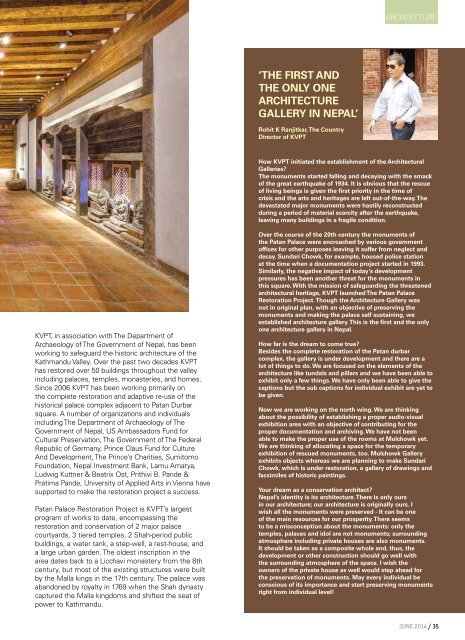7. July 2014
Create successful ePaper yourself
Turn your PDF publications into a flip-book with our unique Google optimized e-Paper software.
Architecture<br />
‘THE FIRST AND<br />
THE ONLY ONE<br />
ARCHITECTURE<br />
GALLERY IN NEPAL’<br />
Rohit K Ranjitkar, The Country<br />
Director of KVPT<br />
How KVPT initiated the establishment of the Architectural<br />
Galleries?<br />
The monuments started falling and decaying with the smack<br />
of the great earthquake of 1934. It is obvious that the rescue<br />
of living beings is given the first priority in the time of<br />
crisis and the arts and heritages are left out-of-the-way. The<br />
devastated major monuments were hastily reconstructed<br />
during a period of material scarcity after the earthquake,<br />
leaving many buildings in a fragile condition.<br />
KVPT, in association with The Department of<br />
Archaeology of The Government of Nepal, has been<br />
working to safeguard the historic architecture of the<br />
Kathmandu Valley. Over the past two decades KVPT<br />
has restored over 50 buildings throughout the valley<br />
including palaces, temples, monasteries, and homes.<br />
Since 2006 KVPT has been working primarily on<br />
the complete restoration and adaptive re-use of the<br />
historical palace complex adjacent to Patan Durbar<br />
square. A number of organizations and individuals<br />
including The Department of Archaeology of The<br />
Government of Nepal, US Ambassadors Fund for<br />
Cultural Preservation, The Government of The Federal<br />
Republic of Germany, Prince Claus Fund for Culture<br />
And Development, The Prince’s Charities, Sumitomo<br />
Foundation, Nepal Investment Bank, Lamu Amatya,<br />
Ludwig Kuttner & Beatrix Ost, Prithivi B. Pande &<br />
Pratima Pande, University of Applied Arts in Vienna have<br />
supported to make the restoration project a success.<br />
Patan Palace Restoration Project is KVPT’s largest<br />
program of works to date, encompassing the<br />
restoration and conservation of 2 major palace<br />
courtyards, 3 tiered temples, 2 Shah-period public<br />
buildings, a water tank, a step-well, a rest-house, and<br />
a large urban garden. The oldest inscription in the<br />
area dates back to a Licchavi monastery from the 8th<br />
century, but most of the existing structures were built<br />
by the Malla kings in the 17th century. The palace was<br />
abandoned by royalty in 1769 when the Shah dynasty<br />
captured the Malla kingdoms and shifted the seat of<br />
power to Kathmandu.<br />
Over the course of the 20th century the monuments of<br />
the Patan Palace were encroached by various government<br />
offices for other purposes leaving it suffer from neglect and<br />
decay. Sundari Chowk, for example, housed police station<br />
at the time when a documentation project started in 1993.<br />
Similarly, the negative impact of today’s development<br />
pressures has been another threat for the monuments in<br />
this square. With the mission of safeguarding the threatened<br />
architectural heritage, KVPT launched The Patan Palace<br />
Restoration Project. Though the Architecture Gallery was<br />
not in original plan, with an objective of preserving the<br />
monuments and making the palace self sustaining, we<br />
established architecture gallery. This is the first and the only<br />
one architecture gallery in Nepal.<br />
How far is the dream to come true?<br />
Besides the complete restoration of the Patan durbar<br />
complex, the gallery is under development and there are a<br />
lot of things to do. We are focused on the elements of the<br />
architecture like tundals and pillars and we have been able to<br />
exhibit only a few things. We have only been able to give the<br />
captions but the sub captions for individual exhibit are yet to<br />
be given.<br />
Now we are working on the north wing. We are thinking<br />
about the possibility of establishing a proper audio-visual<br />
exhibition area with an objective of contributing for the<br />
proper documentation and archiving. We have not been<br />
able to make the proper use of the rooms at Mulchowk yet.<br />
We are thinking of allocating a space for the temporary<br />
exhibition of rescued monuments, too. Mulchowk Gallery<br />
exhibits objects whereas we are planning to make Sundari<br />
Chowk, which is under restoration, a gallery of drawings and<br />
facsimiles of historic paintings.<br />
Your dream as a conservation architect?<br />
Nepal’s identity is its architecture. There is only ours<br />
in our architecture; our architecture is originally ours. I<br />
wish all the monuments were preserved - It can be one<br />
of the main resources for our prosperity. There seems<br />
to be a misconception about the monuments: only the<br />
temples, palaces and idol are not monuments; surrounding<br />
atmosphere including private houses are also monuments.<br />
It should be taken as a composite whole and, thus, the<br />
development or other construction should go well with<br />
the surrounding atmosphere of the space. I wish the<br />
owners of the private house as well would step ahead for<br />
the preservation of monuments. May every individual be<br />
conscious of its importance and start preserving monuments<br />
right from individual level!<br />
june <strong>2014</strong> / 35


















